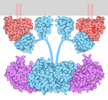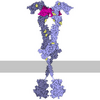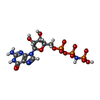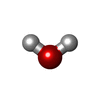[English] 日本語
 Yorodumi
Yorodumi- PDB-9nzm: Crystal Structure of Kirsten Rat Sarcoma G12C Complexed with GMPP... -
+ Open data
Open data
- Basic information
Basic information
| Entry | Database: PDB / ID: 9nzm | ||||||
|---|---|---|---|---|---|---|---|
| Title | Crystal Structure of Kirsten Rat Sarcoma G12C Complexed with GMPPNP and Covalently Bound to an Adduct of {(2S)-4-[7-(8-chloronaphthalen-1-yl)-2-{[(2S)-1-methylpyrrolidin-2-yl]methoxy}-5,6,7,8-tetrahydropyrido[3,4-d]pyrimidin-4-yl]-1-[(2Z)-2-fluoro-3-(pyridin-2-yl)prop-2-enoyl]piperazin-2-yl}acetonitrile | ||||||
 Components Components | Isoform 2B of GTPase KRas | ||||||
 Keywords Keywords | HYDROLASE/HYDROLASE INHIBITOR / KRAS / GTPASE / INHIBITOR / HYDROLASE / HYDROLASE-HYDROLASE INHIBITOR complex | ||||||
| Function / homology |  Function and homology information Function and homology informationresponse to mineralocorticoid / GMP binding / forebrain astrocyte development / LRR domain binding / regulation of synaptic transmission, GABAergic / negative regulation of epithelial cell differentiation / response to isolation stress / response to gravity / epithelial tube branching involved in lung morphogenesis / type I pneumocyte differentiation ...response to mineralocorticoid / GMP binding / forebrain astrocyte development / LRR domain binding / regulation of synaptic transmission, GABAergic / negative regulation of epithelial cell differentiation / response to isolation stress / response to gravity / epithelial tube branching involved in lung morphogenesis / type I pneumocyte differentiation / Rac protein signal transduction / positive regulation of Rac protein signal transduction / Signaling by RAS GAP mutants / Signaling by RAS GTPase mutants / Activation of RAS in B cells / myoblast proliferation / skeletal muscle cell differentiation / RAS signaling downstream of NF1 loss-of-function variants / RUNX3 regulates p14-ARF / positive regulation of glial cell proliferation / SOS-mediated signalling / Activated NTRK3 signals through RAS / Activated NTRK2 signals through RAS / SHC1 events in ERBB4 signaling / cardiac muscle cell proliferation / Signalling to RAS / Activated NTRK2 signals through FRS2 and FRS3 / SHC-related events triggered by IGF1R / Estrogen-stimulated signaling through PRKCZ / glial cell proliferation / SHC-mediated cascade:FGFR3 / MET activates RAS signaling / SHC-mediated cascade:FGFR2 / PTK6 Regulates RHO GTPases, RAS GTPase and MAP kinases / Signaling by PDGFRA transmembrane, juxtamembrane and kinase domain mutants / Signaling by PDGFRA extracellular domain mutants / SHC-mediated cascade:FGFR4 / Erythropoietin activates RAS / SHC-mediated cascade:FGFR1 / Signaling by FGFR4 in disease / FRS-mediated FGFR3 signaling / Signaling by CSF3 (G-CSF) / Signaling by FLT3 ITD and TKD mutants / FRS-mediated FGFR2 signaling / FRS-mediated FGFR4 signaling / p38MAPK events / FRS-mediated FGFR1 signaling / Signaling by FGFR3 in disease / protein-membrane adaptor activity / Tie2 Signaling / striated muscle cell differentiation / Signaling by FGFR2 in disease / GRB2 events in EGFR signaling / SHC1 events in EGFR signaling / Signaling by FLT3 fusion proteins / FLT3 Signaling / Signaling by FGFR1 in disease / EGFR Transactivation by Gastrin / NCAM signaling for neurite out-growth / homeostasis of number of cells within a tissue / CD209 (DC-SIGN) signaling / GRB2 events in ERBB2 signaling / Downstream signal transduction / Insulin receptor signalling cascade / SHC1 events in ERBB2 signaling / Ras activation upon Ca2+ influx through NMDA receptor / response to glucocorticoid / Constitutive Signaling by Overexpressed ERBB2 / Signaling by phosphorylated juxtamembrane, extracellular and kinase domain KIT mutants / VEGFR2 mediated cell proliferation / small monomeric GTPase / FCERI mediated MAPK activation / liver development / Signaling by ERBB2 TMD/JMD mutants / female pregnancy / RAF activation / Signaling by SCF-KIT / Signaling by high-kinase activity BRAF mutants / Constitutive Signaling by EGFRvIII / regulation of long-term neuronal synaptic plasticity / MAP2K and MAPK activation / Signaling by ERBB2 ECD mutants / Signaling by ERBB2 KD Mutants / visual learning / cytoplasmic side of plasma membrane / cytokine-mediated signaling pathway / Regulation of RAS by GAPs / Signaling by CSF1 (M-CSF) in myeloid cells / RAS processing / Negative regulation of MAPK pathway / Signaling by RAF1 mutants / Signaling by moderate kinase activity BRAF mutants / Paradoxical activation of RAF signaling by kinase inactive BRAF / Signaling downstream of RAS mutants / GDP binding / Signaling by BRAF and RAF1 fusions / positive regulation of cellular senescence / DAP12 signaling / MAPK cascade / Constitutive Signaling by Ligand-Responsive EGFR Cancer Variants Similarity search - Function | ||||||
| Biological species |  Homo sapiens (human) Homo sapiens (human) | ||||||
| Method |  X-RAY DIFFRACTION / X-RAY DIFFRACTION /  SYNCHROTRON / SYNCHROTRON /  MOLECULAR REPLACEMENT / Resolution: 1.586 Å MOLECULAR REPLACEMENT / Resolution: 1.586 Å | ||||||
 Authors Authors | Sheriff, S. / Pokross, M. / Witmer, M. | ||||||
| Funding support | 1items
| ||||||
 Citation Citation |  Journal: To be published Journal: To be publishedTitle: Novel covalent warhead imparts potent activity against both GDP- and GTP-bound forms of KRAS G12C Authors: Condakes, M.L. / Zhang, Z. / Danahy, D.B. / Moore, R.R. / Lakkaraju, S.K. / Zhuo, X. / Amako, Y. / Borzilleri, R.M. / Balachander, S.B. / Chourb, L. / Civiello, R.L. / Dongre, A.R. / Downes, ...Authors: Condakes, M.L. / Zhang, Z. / Danahy, D.B. / Moore, R.R. / Lakkaraju, S.K. / Zhuo, X. / Amako, Y. / Borzilleri, R.M. / Balachander, S.B. / Chourb, L. / Civiello, R.L. / Dongre, A.R. / Downes, D.P. / Drexler, D.M. / Dudiak, B.M. / Dzhekieva, L. / El-Samin, M. / Fink, B.E. / Frederick, K. / Huang, C. / Khan, J. / Lees, E. / Levins, C.G. / McCarthy, C. / Mintier, G.A. / Mosure, K. / Parker, M.F. / Powles, R. / Qi, J. / Ruzanov, M. / Sharma, S. / Sheriff, S. / Singh, A.K. / Stedman, J. / Szapiel, N. / Thompson, R.L. / Vaccaro, W. / Wang, T. / Yang, T. / You, D. / Meyer, M.J. / Bronson, J.J. / Stewart, M.L. | ||||||
| History |
|
- Structure visualization
Structure visualization
| Structure viewer | Molecule:  Molmil Molmil Jmol/JSmol Jmol/JSmol |
|---|
- Downloads & links
Downloads & links
- Download
Download
| PDBx/mmCIF format |  9nzm.cif.gz 9nzm.cif.gz | 147 KB | Display |  PDBx/mmCIF format PDBx/mmCIF format |
|---|---|---|---|---|
| PDB format |  pdb9nzm.ent.gz pdb9nzm.ent.gz | Display |  PDB format PDB format | |
| PDBx/mmJSON format |  9nzm.json.gz 9nzm.json.gz | Tree view |  PDBx/mmJSON format PDBx/mmJSON format | |
| Others |  Other downloads Other downloads |
-Validation report
| Summary document |  9nzm_validation.pdf.gz 9nzm_validation.pdf.gz | 1.5 MB | Display |  wwPDB validaton report wwPDB validaton report |
|---|---|---|---|---|
| Full document |  9nzm_full_validation.pdf.gz 9nzm_full_validation.pdf.gz | 1.5 MB | Display | |
| Data in XML |  9nzm_validation.xml.gz 9nzm_validation.xml.gz | 19.2 KB | Display | |
| Data in CIF |  9nzm_validation.cif.gz 9nzm_validation.cif.gz | 25.8 KB | Display | |
| Arichive directory |  https://data.pdbj.org/pub/pdb/validation_reports/nz/9nzm https://data.pdbj.org/pub/pdb/validation_reports/nz/9nzm ftp://data.pdbj.org/pub/pdb/validation_reports/nz/9nzm ftp://data.pdbj.org/pub/pdb/validation_reports/nz/9nzm | HTTPS FTP |
-Related structure data
| Related structure data |  9nznC C: citing same article ( |
|---|---|
| Similar structure data | Similarity search - Function & homology  F&H Search F&H Search |
- Links
Links
- Assembly
Assembly
| Deposited unit | 
| ||||||||
|---|---|---|---|---|---|---|---|---|---|
| 1 | 
| ||||||||
| 2 | 
| ||||||||
| Unit cell |
|
- Components
Components
| #1: Protein | Mass: 19480.916 Da / Num. of mol.: 2 / Mutation: G12C, C51S, C80L, C121S Source method: isolated from a genetically manipulated source Source: (gene. exp.)  Homo sapiens (human) / Gene: KRAS, KRAS2, RASK2 / Production host: Homo sapiens (human) / Gene: KRAS, KRAS2, RASK2 / Production host:  #2: Chemical | #3: Chemical | Mass: 683.217 Da / Num. of mol.: 2 / Source method: obtained synthetically / Formula: C37H40ClFN8O2 / Feature type: SUBJECT OF INVESTIGATION #4: Chemical | #5: Water | ChemComp-HOH / | Has ligand of interest | Y | Has protein modification | Y | |
|---|
-Experimental details
-Experiment
| Experiment | Method:  X-RAY DIFFRACTION / Number of used crystals: 1 X-RAY DIFFRACTION / Number of used crystals: 1 |
|---|
- Sample preparation
Sample preparation
| Crystal | Density Matthews: 3 Å3/Da / Density % sol: 58 % |
|---|---|
| Crystal grow | Temperature: 277 K / Method: vapor diffusion, hanging drop / pH: 6.5 Details: 100 MM Sodium cacodylate, pH 6.5, 1 M tri-sodium citrate dihydrate |
-Data collection
| Diffraction | Mean temperature: 100 K / Serial crystal experiment: N | ||||||||||||||||||||||||||||||||||||||||||||||||||||||||||||||||||||||||||||||||||||||||||||||||||||||||||||||||||||||||||||||||||||||||||||||||||||||||||||||||||||||||||||||||||||||||||||||||||||||||||||||||||||||||||||||||||||||||||||||||||||||||||||||||||||||||||||||||||||||||||||||||||||||||||||||||||||||||||||||||||||||||||||||||||||||||||||||||||||||||||||||||||||||||||||||||||||||||||||||||||||||||||||||||||||||
|---|---|---|---|---|---|---|---|---|---|---|---|---|---|---|---|---|---|---|---|---|---|---|---|---|---|---|---|---|---|---|---|---|---|---|---|---|---|---|---|---|---|---|---|---|---|---|---|---|---|---|---|---|---|---|---|---|---|---|---|---|---|---|---|---|---|---|---|---|---|---|---|---|---|---|---|---|---|---|---|---|---|---|---|---|---|---|---|---|---|---|---|---|---|---|---|---|---|---|---|---|---|---|---|---|---|---|---|---|---|---|---|---|---|---|---|---|---|---|---|---|---|---|---|---|---|---|---|---|---|---|---|---|---|---|---|---|---|---|---|---|---|---|---|---|---|---|---|---|---|---|---|---|---|---|---|---|---|---|---|---|---|---|---|---|---|---|---|---|---|---|---|---|---|---|---|---|---|---|---|---|---|---|---|---|---|---|---|---|---|---|---|---|---|---|---|---|---|---|---|---|---|---|---|---|---|---|---|---|---|---|---|---|---|---|---|---|---|---|---|---|---|---|---|---|---|---|---|---|---|---|---|---|---|---|---|---|---|---|---|---|---|---|---|---|---|---|---|---|---|---|---|---|---|---|---|---|---|---|---|---|---|---|---|---|---|---|---|---|---|---|---|---|---|---|---|---|---|---|---|---|---|---|---|---|---|---|---|---|---|---|---|---|---|---|---|---|---|---|---|---|---|---|---|---|---|---|---|---|---|---|---|---|---|---|---|---|---|---|---|---|---|---|---|---|---|---|---|---|---|---|---|---|---|---|---|---|---|---|---|---|---|---|---|---|---|---|---|---|---|---|---|---|---|---|---|---|---|---|---|---|---|---|---|---|---|---|---|---|---|---|---|---|---|---|---|---|---|---|---|---|---|---|---|---|---|---|---|---|---|---|---|---|---|---|---|---|---|---|---|---|---|---|---|---|---|---|---|---|---|---|---|---|---|---|---|---|---|---|---|---|---|---|---|
| Diffraction source | Source:  SYNCHROTRON / Site: SYNCHROTRON / Site:  APS APS  / Beamline: 17-ID / Wavelength: 1 Å / Beamline: 17-ID / Wavelength: 1 Å | ||||||||||||||||||||||||||||||||||||||||||||||||||||||||||||||||||||||||||||||||||||||||||||||||||||||||||||||||||||||||||||||||||||||||||||||||||||||||||||||||||||||||||||||||||||||||||||||||||||||||||||||||||||||||||||||||||||||||||||||||||||||||||||||||||||||||||||||||||||||||||||||||||||||||||||||||||||||||||||||||||||||||||||||||||||||||||||||||||||||||||||||||||||||||||||||||||||||||||||||||||||||||||||||||||||||
| Detector | Type: DECTRIS EIGER X 9M / Detector: PIXEL / Date: Oct 7, 2021 | ||||||||||||||||||||||||||||||||||||||||||||||||||||||||||||||||||||||||||||||||||||||||||||||||||||||||||||||||||||||||||||||||||||||||||||||||||||||||||||||||||||||||||||||||||||||||||||||||||||||||||||||||||||||||||||||||||||||||||||||||||||||||||||||||||||||||||||||||||||||||||||||||||||||||||||||||||||||||||||||||||||||||||||||||||||||||||||||||||||||||||||||||||||||||||||||||||||||||||||||||||||||||||||||||||||||
| Radiation | Protocol: SINGLE WAVELENGTH / Monochromatic (M) / Laue (L): M / Scattering type: x-ray | ||||||||||||||||||||||||||||||||||||||||||||||||||||||||||||||||||||||||||||||||||||||||||||||||||||||||||||||||||||||||||||||||||||||||||||||||||||||||||||||||||||||||||||||||||||||||||||||||||||||||||||||||||||||||||||||||||||||||||||||||||||||||||||||||||||||||||||||||||||||||||||||||||||||||||||||||||||||||||||||||||||||||||||||||||||||||||||||||||||||||||||||||||||||||||||||||||||||||||||||||||||||||||||||||||||||
| Radiation wavelength | Wavelength: 1 Å / Relative weight: 1 | ||||||||||||||||||||||||||||||||||||||||||||||||||||||||||||||||||||||||||||||||||||||||||||||||||||||||||||||||||||||||||||||||||||||||||||||||||||||||||||||||||||||||||||||||||||||||||||||||||||||||||||||||||||||||||||||||||||||||||||||||||||||||||||||||||||||||||||||||||||||||||||||||||||||||||||||||||||||||||||||||||||||||||||||||||||||||||||||||||||||||||||||||||||||||||||||||||||||||||||||||||||||||||||||||||||||
| Reflection | Resolution: 1.586→58.587 Å / Num. obs: 41310 / % possible obs: 90.7 % / Redundancy: 5.35 % Details: Some remarks regarding the mmCIF items written, the PDB Exchange Dictionary (PDBx/mmCIF) Version 5.0 supporting the data files in the current PDB archive (dictionary version 5.325, last ...Details: Some remarks regarding the mmCIF items written, the PDB Exchange Dictionary (PDBx/mmCIF) Version 5.0 supporting the data files in the current PDB archive (dictionary version 5.325, last updated 2020-04-13: http://mmcif.wwpdb.org/dictionaries/mmcif_pdbx_v50.dic/Index/) and the actual quantities provided by MRFANA (https://github.com/githubgphl/MRFANA) from the autoPROC package (https://www.globalphasing.com/autoproc/). In general, the mmCIF categories here should provide items that are currently used in the PDB archive. If there are alternatives, the one recommended by the PDB developers has been selected. The distinction between *_all and *_obs quantities is not always clear: often only one version is actively used within the PDB archive (or is the one recommended by PDB developers). The intention of distinguishing between classes of reflections before and after some kind of observation criterion was applied, can in principle be useful - but such criteria change in various ways throughout the data processing steps (rejection of overloaded or too partial reflections, outlier/misfit rejections during scaling etc) and there is no retrospect computation of data scaling/merging statistics for the reflections used in the final refinement (where another observation criterion might have been applied). Typical data processing will usually only provide one version of statistics at various stages and these are given in the recommended item here, irrespective of the "_all" and "_obs" connotation, see e.g. the use of _reflns.pdbx_Rmerge_I_obs, _reflns.pdbx_Rrim_I_all and _reflns.pdbx_Rpim_I_all. Please note that all statistics related to "merged intensities" (or "merging") are based on inverse-variance weighting of the individual measurements making up a symmetry-unique reflection. This is standard for several decades now, even if some of the dictionary definitions seem to suggest that a simple "mean" or "average" intensity is being used instead. R-values are always given for all symmetry-equivalent reflections following Friedel's law, i.e. Bijvoet pairs are not treated separately (since we want to describe the overall mean intensity and not the mean I(+) and I(-) here). The Rrim metric is identical to the Rmeas R-value and only differs in name. _reflns.pdbx_number_measured_all is the number of measured intensities just before the final merging step (at which point no additional rejection takes place). _reflns.number_obs is the number of symmetry-unique observations, i.e. the result of merging those measurements via inverse-variance weighting. _reflns.pdbx_netI_over_sigmaI is based on the merged intensities (_reflns.number_obs) as expected. _reflns.pdbx_redundancy is synonymous with "multiplicity". The per-shell item _reflns_shell.number_measured_all corresponds to the overall value _reflns.pdbx_number_measured_all. The per-shell item _reflns_shell.number_unique_all corresponds to the overall value _reflns.number_obs. The per-shell item _reflns_shell.percent_possible_all corresponds to the overall value _reflns.percent_possible_obs. The per-shell item _reflns_shell.meanI_over_sigI_obs corresponds to the overall value given as _reflns.pdbx_netI_over_sigmaI. But be aware of the incorrect definition of the former in the current dictionary! CC1/2: 0.996 / CC1/2 anomalous: -0.316 / Rmerge(I) obs: 0.107 / Rpim(I) all: 0.0504 / Rrim(I) all: 0.1187 / AbsDiff over sigma anomalous: 0.695 / Baniso tensor eigenvalue 1: 0 Å2 / Baniso tensor eigenvalue 2: 17.1806 Å2 / Baniso tensor eigenvalue 3: 0.9888 Å2 / Baniso tensor eigenvector 1 ortho1: 0.9543 / Baniso tensor eigenvector 1 ortho2: 0 / Baniso tensor eigenvector 1 ortho3: -0.2988 / Baniso tensor eigenvector 2 ortho1: 0 / Baniso tensor eigenvector 2 ortho2: 1 / Baniso tensor eigenvector 2 ortho3: 0 / Baniso tensor eigenvector 3 ortho1: 0.2988 / Baniso tensor eigenvector 3 ortho2: 0 / Baniso tensor eigenvector 3 ortho3: 0.9543 / Aniso diffraction limit 1: 1.611 Å / Aniso diffraction limit 2: 2.072 Å / Aniso diffraction limit 3: 1.628 Å / Aniso diffraction limit axis 1 ortho1: 0.76604 / Aniso diffraction limit axis 1 ortho2: 0 / Aniso diffraction limit axis 1 ortho3: -0.64283 / Aniso diffraction limit axis 2 ortho1: 0 / Aniso diffraction limit axis 2 ortho2: 1 / Aniso diffraction limit axis 2 ortho3: 0 / Aniso diffraction limit axis 3 ortho1: 0.64283 / Aniso diffraction limit axis 3 ortho2: 0 / Aniso diffraction limit axis 3 ortho3: 0.76604 / Net I/σ(I): 8.38 / Num. measured all: 221095 / Observed signal threshold: 1.2 / Orthogonalization convention: pdb / % possible anomalous: 89.9 / % possible ellipsoidal: 90.7 / % possible ellipsoidal anomalous: 89.9 / % possible spherical: 67.1 / % possible spherical anomalous: 65.8 / Redundancy anomalous: 2.74 / Signal type: local Reflection shell |
|
- Processing
Processing
| Software |
| ||||||||||||||||||||||||||||||||||||||||||||||||||||||||||||||||||
|---|---|---|---|---|---|---|---|---|---|---|---|---|---|---|---|---|---|---|---|---|---|---|---|---|---|---|---|---|---|---|---|---|---|---|---|---|---|---|---|---|---|---|---|---|---|---|---|---|---|---|---|---|---|---|---|---|---|---|---|---|---|---|---|---|---|---|---|
| Refinement | Method to determine structure:  MOLECULAR REPLACEMENT / Resolution: 1.586→18.14 Å / Cor.coef. Fo:Fc: 0.941 / Cor.coef. Fo:Fc free: 0.935 / SU R Cruickshank DPI: 0.149 / Cross valid method: THROUGHOUT / SU R Blow DPI: 0.119 / SU Rfree Blow DPI: 0.11 / SU Rfree Cruickshank DPI: 0.11 MOLECULAR REPLACEMENT / Resolution: 1.586→18.14 Å / Cor.coef. Fo:Fc: 0.941 / Cor.coef. Fo:Fc free: 0.935 / SU R Cruickshank DPI: 0.149 / Cross valid method: THROUGHOUT / SU R Blow DPI: 0.119 / SU Rfree Blow DPI: 0.11 / SU Rfree Cruickshank DPI: 0.11
| ||||||||||||||||||||||||||||||||||||||||||||||||||||||||||||||||||
| Displacement parameters | Biso mean: 25.46 Å2
| ||||||||||||||||||||||||||||||||||||||||||||||||||||||||||||||||||
| Refine analyze | Luzzati coordinate error obs: 0.25 Å | ||||||||||||||||||||||||||||||||||||||||||||||||||||||||||||||||||
| Refinement step | Cycle: LAST / Resolution: 1.586→18.14 Å
| ||||||||||||||||||||||||||||||||||||||||||||||||||||||||||||||||||
| Refine LS restraints |
| ||||||||||||||||||||||||||||||||||||||||||||||||||||||||||||||||||
| LS refinement shell | Resolution: 1.59→1.7 Å
|
 Movie
Movie Controller
Controller


 PDBj
PDBj























